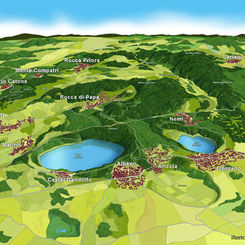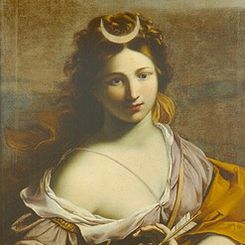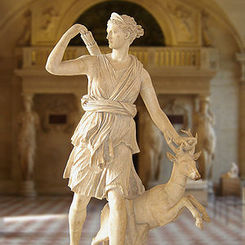Origin and geology

The territory of the Alban Hills area is of volcanic origin, arising from the collapse of the Latium Volcano hundreds of thousands of years ago. The main mouth of the Latium Volcan occupied the whole air of the inner belt of Castles: later collapsed giving rise to several secondary ports, of which the most important was the current Monte Cavo (949 mt) The other ports have become smaller Volcan lake basins between 100,000 and 20,000 years ago, and most have been drained over the centuries. Alban hills area can be divided into several divisions: the 'area Tuscolana (Colonna, Frascati, Grottaferrata, Monte Porzio Catone, Mount Compass, Rocca di Papa, Rocca Priora being hinge on Frascati,' area or Appia Albana (Lazio Albano, Ariccia Castel Gandolfo) Latium Albano hinge on being el 'area Lanuvina (Lanuvio, Genzano di Roma, Nemi) pin being nominally but actually up on Lanuvio Genzano di Roma. Lariano and Velletri, which could be called Artemisia area, are a stand-alone , as Marino, which represents the essential link between area Tuscolana and Albana.
From Neanderthal man to the city of Latin people:
The work of archeologists has confirmed that Alba Longa really existed, and that the civilization of the Latin peoples was of a noteworthy level. The fertile hills of this area have been populated by man ever since Prehistoric times. Neanderthal man settled here permanently between the modern centres of Castel Gandolfo and Albano, living off hunting wild boar, deer and Elephas antiqus(the straight-tusked elephant). However, we can speak of a real civilization from the VI millennium B.C., when the first Neolithic farmers settled in the area of what are nowadays called Albano, Grottaferrata and Montecòmpatri. The civilization of the Latin people emerges from the IX century B.C., and is divided into three ages: Albana, Romulea and Orientalizing, according to historians. This population accomplished elegant works of art, having contact with Greeks, Etruscans and other peoples of the Mediterranean. Their sanctuaries: Juno Sospita in Lanuvio, Jupiter of Lazio on Monte Cavo, Diana of Nemi near the lake of the same name, all of whom passed on their sacredness to the Romans.
History

Alba Longa, in Italian sources occasionally written Albalonga , was an ancient city of Latium in central Italy southeast of Rome in the Alban Hills. Founder and head of the Latin League, it was destroyed by Rome around the middle of the 7th century BC. In legend, Romulus and Remus, founders of Rome, had come from the royal dynasty of Alba Long, it is located 12 miles southeast of Rome. Alba Longa that it was founded by Ascanius to relieve crowding at Lavinium. Ascanius was the son of the Trojan prince Aeneas and Creusa, daughter of Priam. After the Trojan War, as the city burned, Aeneas escaped to Latium, taking his father Anchises and his child Ascanius with him, though Creusa died during the escape. He placed it at the foot of the Alban Mount and said that it took its name from being extended along a ridge. Dionysius of Halicarnassus repeated the story, but added that Ascanius, following an oracle given to his father, collected other Latin populations as well. Noting that alba means "white" (and longa "long") he translated the name "long white town." Dionysius placed the town between the Alban Mount and the Alban Lake thus beginning a long controversy about its location. Since the 16th century, the site has been at various times identified with the convent of S. Paolo at Palazzola, near Albano, or with Coste Caselle, near Marino, or finally with Castel Gandolfo. On the top of the Monte Cavo (Mons Albanus) was a very ancient shrine consecrated to Jupiter Latiaris. Florus (2nd century) states that the site was selected by Ascanius, who, having founded Alba Longa, invited all the Latins to celebrate sacrifices there to Jupiter, a custom which eventually led to the annual celebration there of the Feriae Latinae, at which all the cities that belonged to the Latin Confederation would gather under the aegis of Alba, sacrificing a white bull, the flesh of which was distributed among all the participants.
The history of Latin : Legend or Reality?

Aricia was an ancient pre-Roman city of Latium, which stood roughly on the site of Ariccia, between Albano and Genzano, on the Via Appia. Represented, the sixteenth miles of the Via Appia, the first mansio or coaching coming from Rome (and the last in the opposite direction) and was the second town after civil Bovillae. According to current studies that depart from Greek mythology (1), the foundation of Aricia would be due to Hippolytus, son of Theseus, the legendary king of Athens around 1210 BC The legend tells of a sudden and brutal death how unjust character of Hippolytus killed Trezene (Greece) from the wrath of the horses that his father Theseus, with the help of the god Poseidon, had imbizzarrire Hippolytus's hourse for revenge against the son, who was was accused of having an affair with his stepmother Phaedra, wife of Theseus. Because of this profound injustice and especially because Hippolytus was the beloved of Artemis, the Greek Goddess (Goddess Diana in Latin) of hunting and chastity to which the character Hippolytus was particularly devoted, was resurrected at the hands of the doctor Ascalepio through 'intercession of the Goddess and was hidden in the sacred grove identified on the Alban Hills between Albano and Genzano precisely the ancient Aricia (ll Nemus), also speaks of Virgil in the seventh canto of "after the resurrection Ippolito is transported by Diana on the Alban Hills " In this forest Hippolytus was named in Latin Virbius (twice-born) and under the protection of the nymph Egeria gave birth to the most important religious center of the Latin of that time in honor of the goddess of hunting and chastity. It is assumed that Virbius was the first Rex Nemorensis, the guardian of the sacred wood of the sacred oak and the famous Golden Bough (The Golden Bough by James Frazer), which represents life and in particular the spirit of the human being . This place was consecrated to the Goddess through a temple Nemorense the so-called Temple of Diana and became cult area for hundreds of years for both the Latin for the Romans then, a work of beauty and religious importance starordinaria built in 500 BC about the popooli Latin, in fact you can still see the ruins of this temple. In those days for pregnant women and those who wished to have a successful birth, used to come here in procession along the Sacred Way, which is still existing and visible in this time yet. The Roman emperor Caligula in this area and in particular on Lake Nemi, even built two large and luxurious Imperial ships on which he spent long summer periods. Of great importance is the recent discovery of archaeological dell'Erme Bifronte Ariccia dated back to 200 AD (pictured here) in the Museum of Roman Ships of Nemi would seem to confirm the existence of a cult of Rex Nemorensis. The statue represents a double-face of a human figure young / elderly shown Hippolytus-Virbius man lived twice, would indicate the cycle of the life: birth and death (The Erme-faced of Aricia Alberto Silvestri). Another fascinating aspect of this mythological story concerns the son of Virbius called with the same name as his father, which, according to Virgil in the Aeneid, Virbius was a great warrior and is said to have fought alongside the king of Rutoli Turno against Aeneas in order to protect the Lazio area (Latin area). In connection with the recent studies we can say that the Trojan prince Aeneas escaped from the city of Troy aproximally in 1184 BC by the Greeks during the Trojan War and when he arrived in the Lazio coast he wanted to marry the beautiful queen Lavinia to create a new dynasty. When Aeneas finally won the war against King Turno he married Lavinia founding a village called Lavinio , a few years later his son Ascanius founded another village called Alablonga giving rise to a dinastiy of the Alban's king then lead to the emergence of Rome. Based to the recent arheological discovery we are now uncovering the many mysteries of Latin civilization and creating a historical thread between mythological and legendary stories told so far.
(1) The myths are stories, metaphors that were used to explain to people high and rough concepts sublime behind the bark mythological always hid a deep theological knowledge.
Diana Goddess of the Hunting

Diana(lt. "heavenly" or "divine") was the goddess of the hunt, being associated with wild animals and woodland, and also of the monn in Roman mythology. In literature she was the equal of the Greek goddess Artemis. Diana was known to be the virgin goddess and looked after virgins and women. She was one of the three maiden goddesses, Diana, Minerva and Vesta, who swore never to marry. Along with her main attributes, Diana was an emblem of chastity Oak groves were especially sacred to her. According to mythology, Diana was born with her twin brother Apollo on the island of Delos, daughter of Jupiter and Latona. Diana made up a triad with two other Roman deities: Egeria the water nymph, her servant and assistant midwife; and Virbius, the woodland god. Diana was an ancient goddess common to all Latin tribes. Therefore many sanctuaries were dedicated to her in the lands inhabited by Latins. The first one is supposed to have been near Alba Longa before the town was destroyed by the Romans. The Arician wood sanctuary near the lake of Nemi was Latin confederal as testified by the dedicatory epigraph quoted by Cato. Diana was initially just the hunting goddess, associated with wild animals and woodlands. She also later became a moon goddess supplanting Titan goddess Luna. She also became the goddess of childbirth and ruled over the countryside. Today you can still admire the majesic ruis of the Temple of Diana located at Nemi's Lake.
